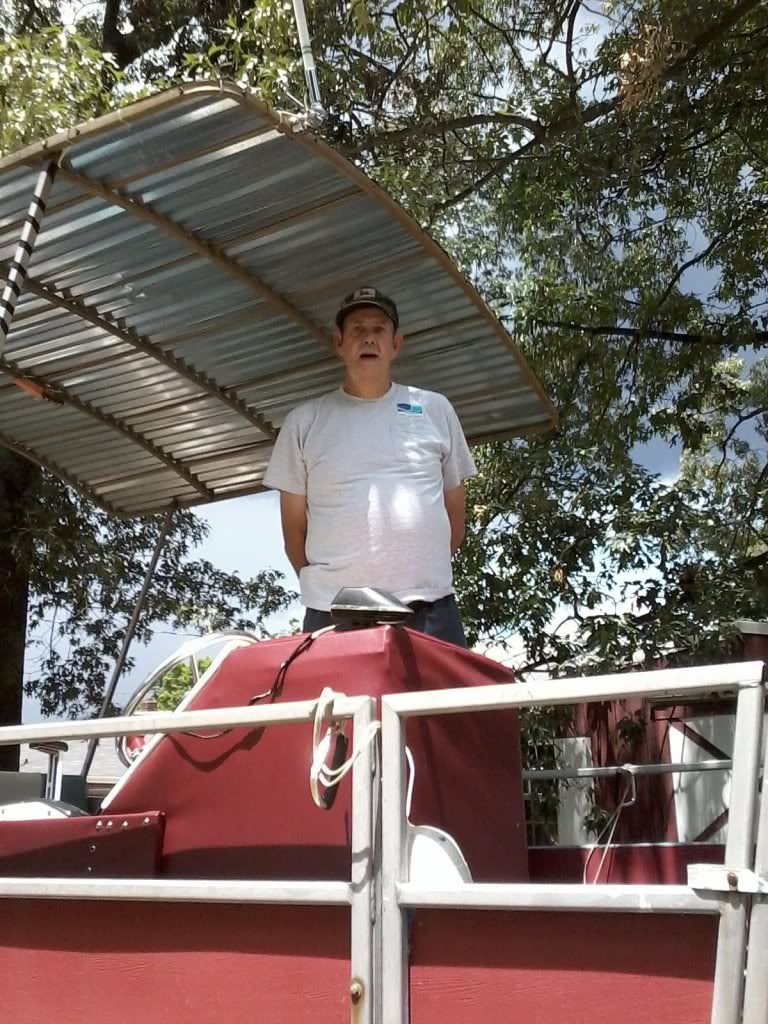Post by BentRod on Dec 11, 2013 22:48:34 GMT -5
Winter Time Jigging 101
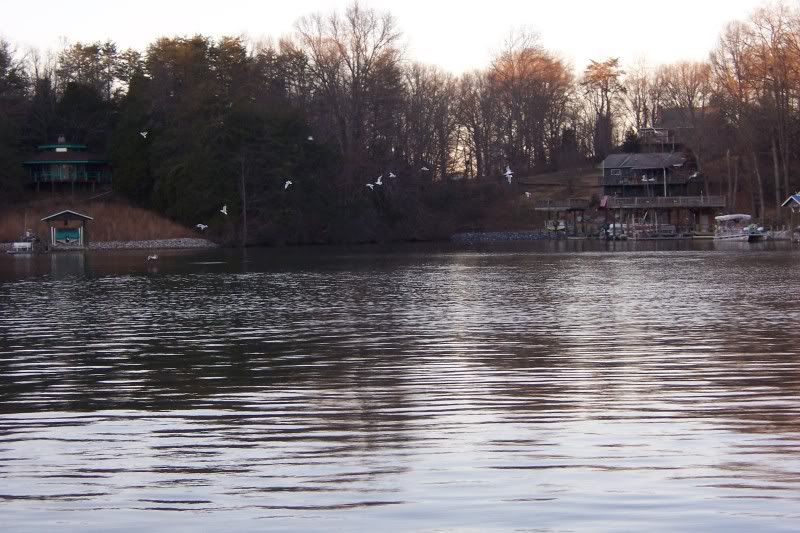
*I wrote the article below for Mward and the SML striper club bulletin so I thought I would share it here also. It's on jigging and just covers the raw basics of it. Most of you can probably jig better than I can, but I'll share it anyhow..
I need to start off this article by giving credit to the individuals that taught me most of what I know about jigging. Those individuals would be Todd Keith, JD Abshire, and Travis Patsell, all of whom have probably been fishing SML for stripers since before I was even born. They have all taught me different, but very effective techniques for jigging year round.
Jigging is an effective technique for stripers in both the winter and summer months when the fish form into large schools. Since we’re now approaching the winter season, I will discuss my winter jigging techniques. As the water temperatures cool into the lows 50 and upper 40 degree range in mid to late December, the fish will begin to form into large aggressive schools. It's the time of year to briefly set aside the live bait or trolling techniques you may use for the majority of the year and get "jiggy" with it! This is also the time of year when the birds will start giving away feeding schools of fish and enable you to cut down on your search time in finding these fish. When the water temperature reaches the mid to low 40 degree mark, the large schools of fish slow down even more and jigging will become even more effective.
Lures
There’s a million different lures you can choose to jig with, but I try to keep my fishing techniques as simple as possible, so I basically only use 3 main lures when jigging: a spoon, a jighead rigged with a Zoom Super fluke, or a bucktail with or without some form of plastic. Each one of these can catch fish while jigging as well as any other lure you can think of. As far as lure weight and size, less is usually better, but 1/2oz to 1oz is about right for most situations on SML. I usually go with either a 3/4oz or 1oz jig so that I can get the lure down fast to the fish below me. As the water cools even more into late January, I will often drop down to a 1/2oz or even smaller to slow the lure presentation down. A stripers metabolism will slow way down when the water reaches the low 40 or even upper 30 degree water temperatures and a slightly slower presentation will often times be the difference in catching and not catching. When rigging your jigheads with a fluke, you can't go wrong with a pearl white or white ice color in most instances. Chartreuse has worked well for me in muddy and murky water situations. Last winter when we had the major flood in January, chartreuse was a particularily good color throughout the jigging season. For spoons, I like just a basic silver or gold spoon with no bucktail on the hook. Keep it simple. You want to create that silver flash that resembles dying bait falling in the water column. In years past with the major threadfin die-offs on the lake, we had had really good success jigging spoons on bottom feeding fish. The past couple years, we haven't done quite as well on spoons; however, with the threadfin population making a small comeback this year, we may see some better results out of spoon fishing this winter. When vertical jigging any of these three lures, I use a split ring and swivel to attach it to my main line to prevent line twist.
Feel free to play with other lures and colors when jigging - there’s no right way to do it. Often times the lure you have the most confidence in fishing is the best choice for you. Stay relatively small though to match the forage these large schools are feeding on in the dead of winter.
Tackle
I like a 6.5-7ft medium to med hvy graphite rod with 12-17lb mono or braid. I personally like braid better when jigging because I can feel through the line so much better than a mono or fluorocarbon line. A lot of fish will hit the lure on the drop, so if you're not paying attention, you'll miss it. This is where braid comes into play and helps you to feel even the slightest ticks or movements in your line. There are even times where you cannot even feel the bite on the drop, but only see it in your line's movement. If there's structure around, which is often the case on SML, I like a MH rod with at least 15lb test. Even a 12-14lb striper can easily take you into the trees when jigging. You need a rod with a decent backbone to get those bigger fish out of there quickly. And often times over the years, we've literally been jigging fish off the bottom and up through the trees, so 8lb test on a small bass rod won't work in those situations.
Techniques
There's no one or right way to jig any lure. Experimentation is the best way to figure out what jigging techniques work best for you and the lures you're using. Over the years, I've learned what generally works for me, but even to this day, I still experiment and change my jigging motion when needed. With spoons, I prefer a long jigging motion the best. A short erratic jigging motion can be effective also on stubborn fish, but I've always done best on the long motion that allows the spoon to "flutter" down. Basically, you are raising your rod 2-3ft in a quick motion and then letting the spoon fall with very little tension on the line so that it "flutters" back down and resembles a dying baitfish. If there's tension on the line, then the spoon loses that erratic flutter motion. You can test/play with your jigging motion near the surface to see how your lure reacts. For most spoons, the "flutter" is generally what draws the strike from fish below and the reason stripers will hit the spoon on the fall almost everytime.
When jigging flukes and bucktails, I prefer a shorter more erratic jigging motion when on fish, which often triggers a reaction bite. However, there is no exact science to it and often times just dead sticking or holding the lure still will result in better catches than an actual jigging motion itself. I'll play with my motion when I'm on fish and let them tell me what they want. I was out on a snowy day last winter jigging flukes with a buddy. I figured out pretty quick that the fish wanted a very slow and short (rise and fall) jigging motion that day. Naturally I didn't tell my friend right off, because as you'll find out or already may know, jigging with friends can be a competition! After I had caught about the fourth fish with birds diving everywhere, he stops and looks at what I'm doing. As soon as he stopped his jigging, BAM, he got a bite. His jig was literally just sitting still. He even ended up outfishing me that day once he slowed it down. So, it just goes to show that small differences in your jigging motion can make big differences in your catch rate. It goes back to the old saying in sports, "Always change a losing game, never change a winning game!"
Outside of watching a striper blowup on a 12" gizzard shad or on a thunderstick right by my boat, jigging is my favorite way to catch these fish. Don't let the cold temperatures keep you off the water, there's plenty of great fishing all winter long. Grab a few of your best buddies and go have a jigging contest!
Few cool jigging shots on the sonar..
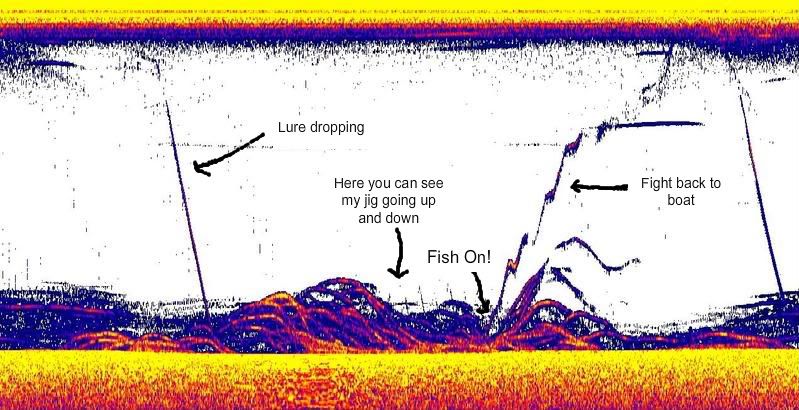
In this one you can see a fish caught on the left side and then released just to the left of the lure being re-dropped and hooking up immediately again!
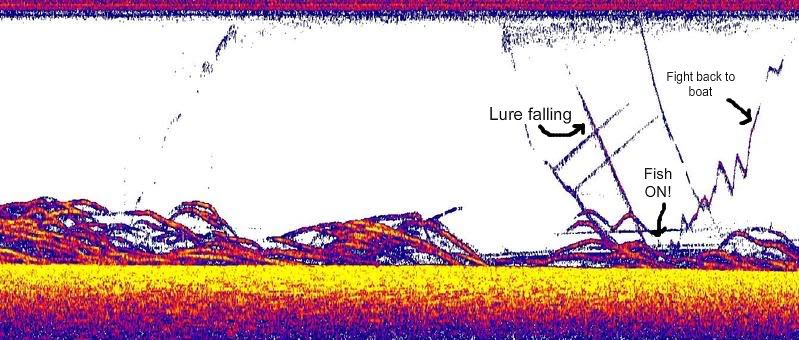
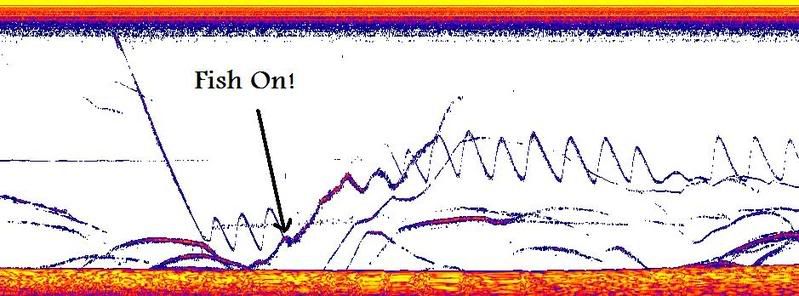
Typical white ice fluke..

See chartreuse does work!
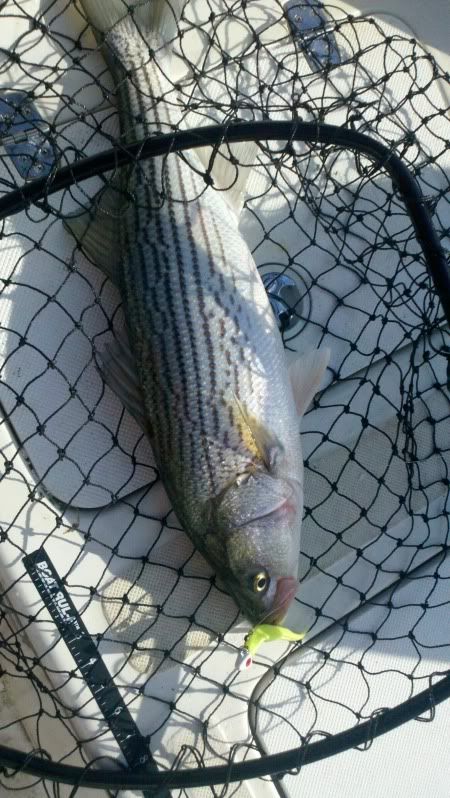

*I wrote the article below for Mward and the SML striper club bulletin so I thought I would share it here also. It's on jigging and just covers the raw basics of it. Most of you can probably jig better than I can, but I'll share it anyhow..
I need to start off this article by giving credit to the individuals that taught me most of what I know about jigging. Those individuals would be Todd Keith, JD Abshire, and Travis Patsell, all of whom have probably been fishing SML for stripers since before I was even born. They have all taught me different, but very effective techniques for jigging year round.
Jigging is an effective technique for stripers in both the winter and summer months when the fish form into large schools. Since we’re now approaching the winter season, I will discuss my winter jigging techniques. As the water temperatures cool into the lows 50 and upper 40 degree range in mid to late December, the fish will begin to form into large aggressive schools. It's the time of year to briefly set aside the live bait or trolling techniques you may use for the majority of the year and get "jiggy" with it! This is also the time of year when the birds will start giving away feeding schools of fish and enable you to cut down on your search time in finding these fish. When the water temperature reaches the mid to low 40 degree mark, the large schools of fish slow down even more and jigging will become even more effective.
Lures
There’s a million different lures you can choose to jig with, but I try to keep my fishing techniques as simple as possible, so I basically only use 3 main lures when jigging: a spoon, a jighead rigged with a Zoom Super fluke, or a bucktail with or without some form of plastic. Each one of these can catch fish while jigging as well as any other lure you can think of. As far as lure weight and size, less is usually better, but 1/2oz to 1oz is about right for most situations on SML. I usually go with either a 3/4oz or 1oz jig so that I can get the lure down fast to the fish below me. As the water cools even more into late January, I will often drop down to a 1/2oz or even smaller to slow the lure presentation down. A stripers metabolism will slow way down when the water reaches the low 40 or even upper 30 degree water temperatures and a slightly slower presentation will often times be the difference in catching and not catching. When rigging your jigheads with a fluke, you can't go wrong with a pearl white or white ice color in most instances. Chartreuse has worked well for me in muddy and murky water situations. Last winter when we had the major flood in January, chartreuse was a particularily good color throughout the jigging season. For spoons, I like just a basic silver or gold spoon with no bucktail on the hook. Keep it simple. You want to create that silver flash that resembles dying bait falling in the water column. In years past with the major threadfin die-offs on the lake, we had had really good success jigging spoons on bottom feeding fish. The past couple years, we haven't done quite as well on spoons; however, with the threadfin population making a small comeback this year, we may see some better results out of spoon fishing this winter. When vertical jigging any of these three lures, I use a split ring and swivel to attach it to my main line to prevent line twist.
Feel free to play with other lures and colors when jigging - there’s no right way to do it. Often times the lure you have the most confidence in fishing is the best choice for you. Stay relatively small though to match the forage these large schools are feeding on in the dead of winter.
Tackle
I like a 6.5-7ft medium to med hvy graphite rod with 12-17lb mono or braid. I personally like braid better when jigging because I can feel through the line so much better than a mono or fluorocarbon line. A lot of fish will hit the lure on the drop, so if you're not paying attention, you'll miss it. This is where braid comes into play and helps you to feel even the slightest ticks or movements in your line. There are even times where you cannot even feel the bite on the drop, but only see it in your line's movement. If there's structure around, which is often the case on SML, I like a MH rod with at least 15lb test. Even a 12-14lb striper can easily take you into the trees when jigging. You need a rod with a decent backbone to get those bigger fish out of there quickly. And often times over the years, we've literally been jigging fish off the bottom and up through the trees, so 8lb test on a small bass rod won't work in those situations.
Techniques
There's no one or right way to jig any lure. Experimentation is the best way to figure out what jigging techniques work best for you and the lures you're using. Over the years, I've learned what generally works for me, but even to this day, I still experiment and change my jigging motion when needed. With spoons, I prefer a long jigging motion the best. A short erratic jigging motion can be effective also on stubborn fish, but I've always done best on the long motion that allows the spoon to "flutter" down. Basically, you are raising your rod 2-3ft in a quick motion and then letting the spoon fall with very little tension on the line so that it "flutters" back down and resembles a dying baitfish. If there's tension on the line, then the spoon loses that erratic flutter motion. You can test/play with your jigging motion near the surface to see how your lure reacts. For most spoons, the "flutter" is generally what draws the strike from fish below and the reason stripers will hit the spoon on the fall almost everytime.
When jigging flukes and bucktails, I prefer a shorter more erratic jigging motion when on fish, which often triggers a reaction bite. However, there is no exact science to it and often times just dead sticking or holding the lure still will result in better catches than an actual jigging motion itself. I'll play with my motion when I'm on fish and let them tell me what they want. I was out on a snowy day last winter jigging flukes with a buddy. I figured out pretty quick that the fish wanted a very slow and short (rise and fall) jigging motion that day. Naturally I didn't tell my friend right off, because as you'll find out or already may know, jigging with friends can be a competition! After I had caught about the fourth fish with birds diving everywhere, he stops and looks at what I'm doing. As soon as he stopped his jigging, BAM, he got a bite. His jig was literally just sitting still. He even ended up outfishing me that day once he slowed it down. So, it just goes to show that small differences in your jigging motion can make big differences in your catch rate. It goes back to the old saying in sports, "Always change a losing game, never change a winning game!"
Outside of watching a striper blowup on a 12" gizzard shad or on a thunderstick right by my boat, jigging is my favorite way to catch these fish. Don't let the cold temperatures keep you off the water, there's plenty of great fishing all winter long. Grab a few of your best buddies and go have a jigging contest!
Few cool jigging shots on the sonar..

In this one you can see a fish caught on the left side and then released just to the left of the lure being re-dropped and hooking up immediately again!


Typical white ice fluke..

See chartreuse does work!



